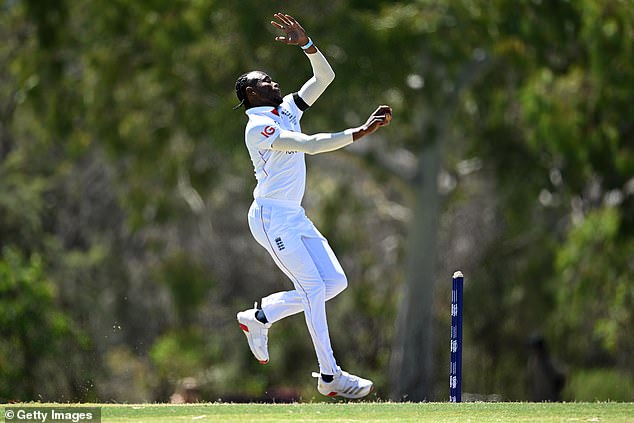A recent quip by Joe Root contained more truth than his smile suggested. Asked about Australian pitches, he replied: ‘It looks like they’re slightly more bowler-friendly since Pat’s been captain.’
And while Pat Cummins will miss next week’s first Test at Perth because of a back niggle, the groundsman at the Optus Stadium has already confirmed his plans to produce a surface similar to the one where 17 wickets fell on the opening day against India last year.
Australia has traditionally been regarded as the most batsman-friendly country in the world, but times have changed – and England will have to adapt if they are to win their first Test there for 15 years, never mind their first series.
Some truisms remain intact. To thrive as a fast bowler Down Under, you must be physically robust, mentally resilient and ready for the flak, from the local batsmen, the media and the spectators.
During England’s successful 2010-11 tour, coach Andy Flower and captain Andrew Strauss spared their fast bowlers unnecessary ear-ache by posting No3 batsman Jonathan Trott on the boundary at fine leg or third man. The abuse he copped is unpublishable, but England believed it was a price worth paying: if one of their quicks had just bowled a poor over, they did not want him returning to the fence to hear exactly how rubbish he was.
This winter, their fast bowlers may find life a touch easier. Not only have Australian pitches livened up, but the Kookaburra ball – long regarded with dread by English seamers because of its small seam and refusal to move laterally after a dozen overs – has more lacquer than before, encouraging more swing.

Ben Stokes (right) and Jofra Archer will have to adapt to a new Kookaburra ball and a different style of pitch in Australia this winter

Archer, seen here in England’s warm-up match with the Lions on Thursday, is the jewel of an England attack blessed with pace

Fellow quick Brydon Carse (pictured) has an admirer in former England man Steven Finn. ‘He has skill as well as attitude,’ says Finn
The stats tell the story. Between the previous two Ashes series in Australia, in 2017-18 and 2021-22, top-seven batsmen there averaged 38, with 34 hundreds in 20 Tests. In the 20 Tests since, the average has dropped to 30, and the hundred count to 24.
English conditions have gone the other way. Since the advent of Bazball in 2022, the average is nearly 39. In the three years before, it was less than 31. Suddenly, it’s England’s batsmen, not Australia’s, who need to get used to the movement – and if their recent 3–0 ODI defeat on spicy pitches in New Zealand is anything to go by, there is work to do.
What of England’s strategy of packing their attack with out-and-out pace? ‘It’s an interesting one, isn’t it?’ says Steven Finn, who was England’s leading wicket-taker after the first three Tests of the 2010-11 Ashes, only to be dropped because of his economy-rate.
‘From Ashes tours I experienced, yes, you have to have pace and bounce to trouble their players. But looking at how wickets have behaved there over the last couple of years, and how little effect their spinner Nathan Lyon has had, I’d be wary of thinking that pace alone is going to be the answer. There needs to be skill too, which clearly these bowlers have. But it’s a shift in mindset.’
It’s no surprise England have gone back to an old friend in David Saker, the 59-year-old Australian fast-bowling coach who regards batsmen with genuine contempt, and was popular with the likes of Stuart Broad and Jimmy Anderson when he began working with Flower’s team in 2010.
Saker, who took 247 first-class wickets for Victoria and Tasmania, once explained his ‘basic philosophy’ like this: ‘To instil the idea that the bowlers are in a battle with the batsman, whether in the nets or out in the middle. The rest is details.’
Perhaps for that reason, Finn describes Saker in his new book as an ‘artist’. He tells Daily Mail Sport: ‘Sakes is very much an end-result bowling coach, so he will always be thinking at the batter’s end of the pitch. How can we get someone out? How can we bowl on a particular wicket? He wasn’t so much a mechanic who looks at the bowling action, which makes him a good fit for this team, because they try to take the pressure away from inside your own head and focus on the battle you’re in.’
Yet for all the talk of helpful pitches and hand-to-hand combat, some aspects of bowling fast in Australia will never change. ‘It’s very physical, with the heat and the hard grounds,’ says Finn. ‘And the drop-in pitches mean you’re running up on football, not cricket, outfields, so you have to be in top condition.

Ben Stokes and England’s Australian bowling guru David Saker will be formulating an Ashes battle plan

Finn, England’s leading wicket-taker after three Tests of the 2010-11 Ashes, celebrates dismissing Mike Hussey in Brisbane. But he says wickets are different now to back in his day

He is now a respected pundit and will be working on TNT Sports’ coverage of this winter’s series Down Under
‘You’re trying to bowl full enough with intent, to find that length where you can hit the splice but still have some bite and zip, because if you live between the hip bone and the shoulder, they love playing balls of that length. And when you bowl a bouncer, it has to be a proper bouncer, to ruffle feathers.
‘But attitude and mindset are also a very big thing. You have to be willing to go back to the well, because there will be long, hot days. Steve Smith will get in at some stage. You need the heart to keep coming back.
‘When I look at the people England have picked, I see a lot of characters who won’t disappear during a day, whose pace won’t drop. Brydon Carse is one I’m looking forward to watching – and he has skill as well as attitude. His angle is in towards the right-handers, and then he can leave them, a bit like Josh Hazlewood and Pat Cummins. Off a good length, he hits the outside edge and it carries to slip.’
Above all, Finn believes, you need to formulate a plan, and stick to it. ‘You can’t be half-arsed,’ he says. ‘In Australia, as a seamer, you have to do everything with intent. If you don’t, you get found out. Commit as much as you can.’
The Ashes Files: My Pride and Pain in Cricket’s Most Intense Series by Steven Finn is out now in hardback, eBook and audiobook

